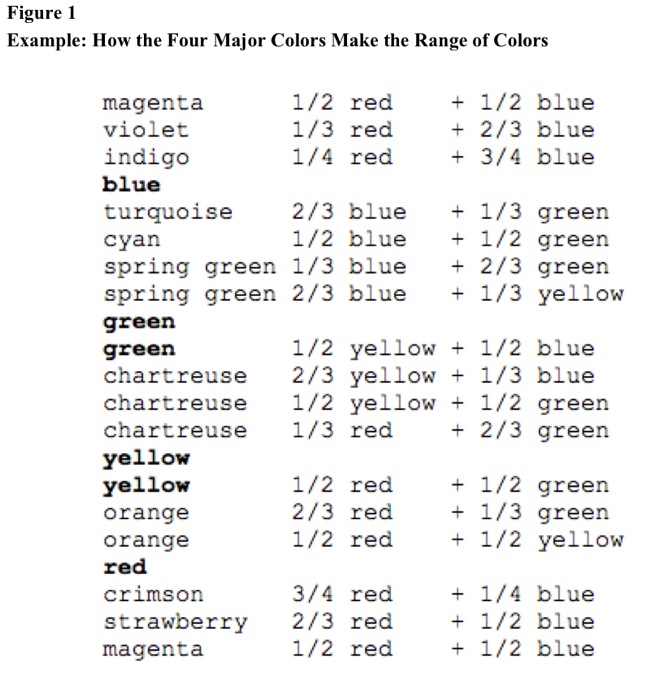
All colors from surface point can mix {color mixture}.
intermediate color
Two colors mix to make the intermediate color. For example, red and orange make red-orange vermilion. See Figure 1.
colors mix uniquely
Colors blend with other colors differently.
additive color mixture
Colors from light sources add {additive color mixture}. No additive spectral-color mixture can make blue or red. Magenta and orange cannot make red, because magenta has blue, orange has yellow and green, and red has no blue or green. Indigo and cyan cannot make blue, because indigo has red and cyan has green, and blue has no green or red.
subtractive color mixture
Colors from pigmented surfaces have colors from source illumination minus colors absorbed by pigments {subtractive color mixture}. Colors from pigment reflections cannot add to make red or to make blue. Blue and yellow pigments reflect green, because both reflect some green, and sum of greens is more than reflected blue or yellow. Red and yellow pigments reflect orange, because each reflects some orange, and sum of oranges is more than reflected red or yellow.
For subtractive colors, mixing cannot make red, blue, or yellow. Magenta and orange cannot make red, because magenta has blue, orange has yellow and green, and red has no blue or green. Indigo and cyan cannot make blue, because indigo has red and cyan has green, and blue has no red or green. Chartreuse and orange cannot make yellow, because chartreuse has green and some indigo, orange has red and some indigo, and yellow has no indigo.
pastel colors
Colors mix with white to make pastel colors.
similarity
Similar colors mix to make the intermediate color.
primary additive colors
Red, green, and blue are the primary additive colors.
primary subtractive colors
Red, yellow, and blue, or magenta, yellow, and cyan, are the primary subtractive colors.
secondary additive colors
Primary additive-color mixtures make secondary additive colors: yellow from red and green, magenta from red and blue, and cyan from green and blue.
secondary subtractive colors
Primary subtractive-color mixtures make secondary subtractive colors: orange from red and yellow, magenta from red and blue, and green from yellow and blue.
tertiary additive colors
Mixing primary and secondary additive colors makes tertiary additive colors: orange from red and yellow, violet from blue and magenta, and chartreuse from yellow and green.
tertiary subtractive colors
Mixing primary and secondary subtractive colors makes tertiary subtractive colors: cyan from blue and green, violet from blue and magenta, and chartreuse from yellow and green.

Consciousness>Consciousness>Sense>Vision>Color Vision>Mixing Colors
1-Consciousness-Sense-Vision-Color Vision-Mixing Colors
Outline of Knowledge Database Home Page
Description of Outline of Knowledge Database
Date Modified: 2022.0224